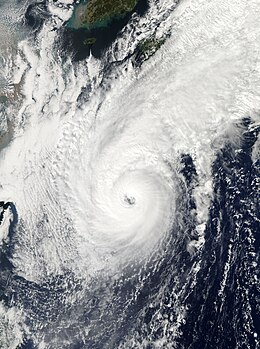Typhoon Chaba (2010)
| Typhoon (JMA scale) | |
|---|---|
| Category 4 (Saffir–Simpson scale) | |

Typhoon Chaba near peak strength off the Ryukyu Islands on 28 October
|
|
| Formed | 20 October 2010 |
| Dissipated | 1 November 2010 |
| (Extratropical after 30 October) | |
| Highest winds |
10-minute sustained: 175 km/h (110 mph) 1-minute sustained: 215 km/h (130 mph) |
| Lowest pressure | 930 hPa (mbar); 27.46 inHg |
| Fatalities | None reported |
| Areas affected | Japan |
| Part of the 2010 Pacific typhoon season | |
Typhoon Chaba, known in the Philippines as Typhoon Katring, was the first typhoon to impact Japan since Typhoon Melor in October 2009. Chaba means Hibiscus in Thai.
Early on 20 October, the Japan Meteorological Agency (JMA) upgraded an area of low pressure into a tropical depression. Later that day, the JMA reported that the tropical depression slightly intensified. The next day, the Joint Typhoon Warning Center started monitoring the system as tropical depression 16W. On 23 October, the system entered the Philippine Area of responsibility and the Philippine Atmospheric, Geophysical and Astronomical Services Administration (PAGASA) started monitoring the system as Tropical Depression "Katring" On 24 October, the JMA and JTWC upgraded the tropical depression into a tropical storm and the JMA named it "Chaba". On 25 October, the JMA further upgraded the storm into a Severe Tropical Storm. Later that day, the JTWC upgraded the storm into a Category 1 Typhoon. Early on 26 October, the JMA further upgraded the storm into a Typhoon. Early on 27 October, the JTWC upgraded the typhoon into a Category 2 Typhoon. Later that day, the JTWC further upgraded the typhoon into a Category 3 Typhoon. The following day JTWC upgraded the system into a Category 4 Typhon. Later that day, the JTWC downgraded Chaba into a Category 3 Typhoon. Early on 29 October, the JTWC further downgraded Chaba into a Category 2 Typhoon, while the JTWC downgraded it into a Category 1 Typhoon. Early on 30 October, the JTWC reported that Chaba had transitioned into an extratropical cyclone. During the afternoon of 30 October, the JMA downgraded Chaba to a remnant low as passed near Japan. The remnants of Chaba continued to weaken as it moved northeast, but strengthened again in approaching the Gulf of Alaska into a major storm with 55-knot winds, kicking up 40–50 foot waves, with pressure as low as 939 mb. The storm's center came ashore in the vicinity of Cordova, Alaska on 1 November, but not before pulling an atmospheric river of moisture into the American Pacific Northwest, setting a record for that date of precipitation in Seattle.
...
Wikipedia
